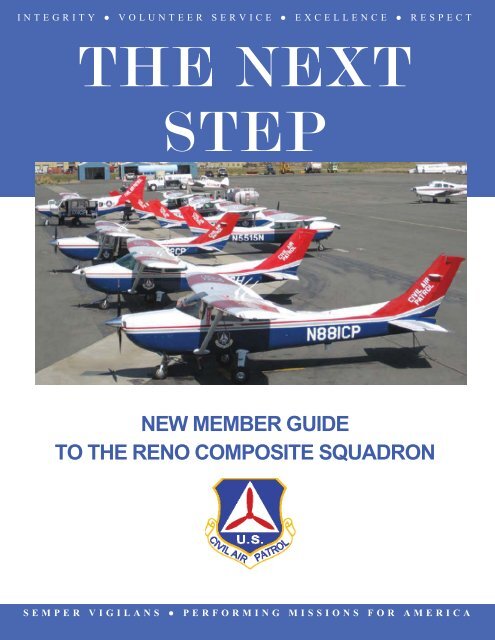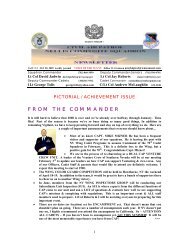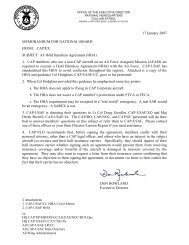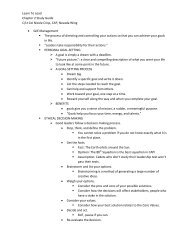New Member Guide PDF - Nevada Wing - Civil Air Patrol
New Member Guide PDF - Nevada Wing - Civil Air Patrol
New Member Guide PDF - Nevada Wing - Civil Air Patrol
You also want an ePaper? Increase the reach of your titles
YUMPU automatically turns print PDFs into web optimized ePapers that Google loves.
THE NEXTSTEPNEW MEMBER GUIDETO THE RENO COMPOSITE SQUADRONSEMPER VIGILANS PERFORMING MISSIONS FOR AMERICA
United States <strong>Air</strong> Force Auxiliary-<strong>Civil</strong> <strong>Air</strong> <strong>Patrol</strong>Reno Composite Squadron PCR-NV-054PO Box 339 Sparks, NV 89432-0339Welcome!On behalf of the members of the Reno Composite Squadron I would like to welcome you to the finestsquadron in the <strong>Civil</strong> <strong>Air</strong> <strong>Patrol</strong>! It is our hope that your association with the <strong>Civil</strong> <strong>Air</strong> <strong>Patrol</strong> will be bothproductive and positive. If you have questions at any point, please feel free to ask either myself or anyother member of the unit.The <strong>Civil</strong> <strong>Air</strong> <strong>Patrol</strong>, commonly referred to simply as CAP, has been the Auxiliary of the United States <strong>Air</strong>Force for over half a century, proudly serving the nation from the days of World War Two to the present.The three basic missions of the <strong>Civil</strong> <strong>Air</strong> <strong>Patrol</strong> are Emergency Services, Aerospace Education, and theCadet Program. Our training and activities are all related to one or more of these central missions. As arequirement of your initial indoctrination to the unit, you will undergo training that will explain themissions more in-depth.Joining any organization is always somewhat confusing at first, with new names, faces, jargon, and waysof doing things to learn. To assist you in adjusting to CAP, this packet condenses some of the questionsmost often asked by new members. A vital information source you should regularly visit is the unit website at http://www.nvwg.cap.gov/index.php?url=squadron/view/nv054.Our meetings are on the 2 nd and 4 th Mondays at 601 South Rock Blvd. Our unit relies on its membersbeing active participants in the activities and training being held. Not only are these events informativeand interesting, they are a vital component of effective, proficient squadrons. Whenever possible, pleaseparticipate and if possible volunteer to help develop and run these exciting programs and activities.Once your membership application and fees have been processed by National Headquarters, <strong>Civil</strong> <strong>Air</strong><strong>Patrol</strong>, you will receive a membership card with your identification and CAPID. This number will be yourprimary means of identification so please memorize it for future use.We look forward to having you as an active member of the Reno Composite Squadron. Welcome, andthank you for donating your time, energy, and enthusiasm!Eric Henry, Capt, CAPSquadron CommanderReno Composite Squadron2
Joining CAPQuick View <strong>New</strong> <strong>Member</strong> Checklist______ Complete CAP Form 12 and present two forms of official ID to the squadroncommander to review & sign,______ Have fingerprint card completed and brought with application______ Make check payable to CAP for $63.00After Joining CAP- Complete Level One and Initial Requirements______ Meet with your assigned mentor to review your progress______ Set up your account with E-Services (www.capnhq.gov) and enter your information,including contact, characteristics, identification, and photo (see directions on photovalidation section of E-Services. Also visit the “Where Do I Start?” module forintroductory information on CAP.______ Complete all parts of the Level One Training- To be completed in person and onlinethrough the Learning Management System (LMS) on E-Services.______ Read CAPR 50-17 Senior <strong>Member</strong> Professional Development Program, available inthe CAP Pubs and Forms module in E-Services______ Complete the General Emergency Services Exam (CAPT 116) online through theCAP Online Courses and Exams module in E-Services______ Read CAPM 39-1 CAP Uniforms Manual, available in the CAP Pubs and Formsmodule in E-Services and the basic guides available through the member servicessection of www.capmember.comAreas youshouldwork onsimultaneouslyasyouprogressin theSenior<strong>Member</strong>ProgramTo Begin Emergency Services Training____________________________________Speak to your mentor about your interest in the Emergency Servicesmission areas in which you will qualifyRead CAPR 60-3 Emergency Services and Operations Manualavailable in the CAP Pubs and Forms module in E-ServicesView the Specialty Qualification Training Report (SQTR) in yourchosen area(s) to determine the required items to completeComplete the open-book online CAPT 117 Exam that applies to youComplete the FEMA Incident Command System (ICS) modules thatapply to your operational field on-line & upload certificates to E-Services for validationPilots need to see the operations officer or the squadron commanderfor answers on qualifying as a CAP pilotWorking Your Way Through the CAP Program__________________Review the specialty tracks and select one that matches the needs ofthe squadron.Consult CAPR 35-5, discuss with the squadron commander aboutany qualification that you have which merits promotions or dutyassignment, such as prior military service.See the squadron commander for assignment into a staff positionunder a current staff officer for additional training.3
Mentoring and Working Towards Your Qualifications and RankMentor Information:________________________________________Name of Your Mentor_____________________________________Best Phone Number to Reach Your Mentor_____________________Rank_________________________________Best E-mail to UseSelect a Senior <strong>Member</strong> Specialty Track200 Personnel214 Communications201 Public Affairs215 Aerospace Education202 Finance216 Cadet Programs203 Inspector General217 Safety204 Professional Development218 Plans and Programs205 Administration221 Chaplain206 Logistics223 Historian210 Flight Operations225 Moral Leadership211 Operations226 Recruiting and Retention212 Standardization-Evaluation227 Information Technology213 Emergency Services228 Drug Demand ReductionTo view the specific requirements for your specialty track please go to E-Services and under thePublications section choose Pamphlets and view the specific requirements for your track. If yourmentor is not rated in the specialty that you have chosen, an OJT advisor will likely be assigned as wellto assist you with completing your technician rating requirements. Completing the technician rating inany of these specialty tracks earns you the leadership ribbon.On The Job Advisor Information:________________________________________Name of Your Mentor_____________________________________Best Phone Number to Reach Your Mentor_____________________Rank_________________________________Best E-mail to UsePromotionsAll members must review CAPR 50-17, available at E-Services, for information on the Senior <strong>Member</strong>program as well as directions on how to earn promotions. You may achieve promotion by completingthe objectives for each level or rating. For example, to be promoted to 1 st Lieutenant, you must be a 2 ndLieutenant for 1 year and have received a Technician Rating in a Specialty Track. You can also receivepromotions based on your background training, jobs held in the squadron, and prior military service.Please review CAPR 50-17 to see if you qualify.4
CAP Pilot and Mission Duty Training ChecklistWelcome to CAP! We value your volunteering spirit and look forward to assisting you in trainingfor CAP aircrew status. This checklist is designed to expedite the process for becoming an aircrewmember, and for pilots the qualifications for CAP Mission Pilot. Pilots need to have a valid andcurrent private pilot’s license and an up-to-date FAA medical exam. See CAPR 60-1, chapter 3,for details about minimum pilot qualifications for CAP. This checklist assumes that you arecurrently flying before joining CAP; the program is not designed to provide free flight instruction tothe senior members. Because we operate high-performance aircraft in <strong>Nevada</strong> we require aminimum of 100 hours and a CAP checkride in order to qualify to be a CAP Pilot.First Months in the Program1. Get General Emergency Services (GES) qualified. The GES test includes measuring yourunderstanding of the Incident Command System (ICS), as well as CAP’s role inemergencies. You can also study the GES materials and take the GES Test online through theCAP Online Courses and Exams module in E-Services: See CAPR 60-3 for details. You willalso need to take specific mini exams, also open-book, that relate to your specific duty areas.These are called the CAPT 117 exams (10 questions each) and are also available in the Examsmodule.2. CAP follows the federal Incident Command System (ICS) format of mission management, soevery member who wants to serve on base staff or an aircrew will have to complete some basiccourse work that is available on the FEMA web site. Each member needs to consult their SQTRrequirements to see what specific classes must be completed. As each member finishes arequired course, download the course completion certificate and upload this into the OperationsQualifications module of E-Services.3. Become familiar with entering information and uploading documents (in pdf form only) intoE-Services. It is always the responsibility of each member to ensure that they maintain upto-daterecords and review training requirements listed in the Specialty Qualification TrainingReport (SQTR) for aircrew and the “What Do I Need” module for pilots, available in the MyOperations Qualifications section for E-Services.4. Make a habit of regularly printing your 101 card from the Operations Qualifications module inE-Services, as it is required for all ground and aircrew participants in a CAP mission. Whentraining in any mission duty assignment, you must also print the SQTR paper and have yourtrainers sign each item they have trained you on. When complete, enter this information intoE-Services, scan your SQTR card, and upload it into E-Services so the squadron officer whowill validate your entries can see you have completed all tasks for the qualification.Preparing for <strong>Air</strong>crew Training5. Start progressing towards Scanner qualification. A CAP Scanner is someone who is trainedto look outside of the aircraft for various mission objectives. Those working towards missionpilot will need to go through this same training. This is done through a wing level in-personcourse and two training flights, with the training regimen detailed in the Mission Task <strong>Guide</strong>under the Emergency Services section of www.capmembers.com. See the squadroncommander or operations officer to begin this training.5
6. Complete the ICUT Communications Training program, available through E-servicesLearning Module. There are a series of training videos and an online exam, followed by anin-person evaluation. See CAPR 100-1 for details.7. All aircrew members operating on ES missions are required to wear a USAF or CAPNOMEX flight suit, so make sure to get the flight suit and boots that meet your needs, basedon weight and grooming conditions. See CAPM 39-1 for details.8. The next phase of aircrew work is the Mission Observer. In addition to looking for missiontargets, the Mission Observer assists the Mission Pilot in navigation and radio operation.Just like the Scanner portion, there is a course and training flights that must be completed.You will need to complete the I-CUT Radio Operator online course (available through e-Services) and pass the practical examination using a CAP radio. Potential mission pilots arerequired to complete this training as well.Preparing for Base Staff Training9. Base staff work as a team with air and ground crews to plan and implement all missions.The Mission Task <strong>Guide</strong> under the Emergency Services section of www.capmembers.comcontains detailed objectives. See the squadron commander or operations officer fordirections on the training requirements. Your training will largely be completed throughparticipation in practice or actual missions.10. Base staff are needed to serve as radio operators, so complete the I-CUT Radio Operatorcourse. The coursework is provided online through e-Services and all participants mustcomplete a practical examination using a CAP radio.Preparing for a CAP Pilot Check Ride/Mission Check Ride11. You must have a discussion with the operations officer to ensure a smooth transition tobecoming a CAP pilot. Review the Operations section of www.capmembers.com. Allprospective CAP pilots must understand the CAP Flight Management program outlined inCAPR 60-1 and complete the CAPR 60-1 online exam within 30 days of your scheduledcheck ride.12. Schedule a check ride with a wing check pilot (called a From 5 check ride). The check ridewill determine your proficiency in safely operating CAP aircraft and consists of groundinstruction, review of your questionnaire, a flight check (not an FAA review), and a debriefwith the check pilot.13. Upload pdf scans of all required FAA documents prior to your check ride as well as CAPquestionnaires and completed CAPF-5 after your successful check ride.14. Once you complete your Form 5 checkride, attained a mission aircrew rating, and have atleast 175 hours PIC you can pursue the mission pilot rating. In addition to understanding therequirements listed in CAPR 60-1 and CAPR 60-3, prospective mission pilots have acurriculum they will have to complete in the Mission Task <strong>Guide</strong> under the EmergencyServices section of www.capmembers.com. Close coordination with the squadronoperations officer will ensure proper preparation for this process.6
<strong>New</strong> <strong>Member</strong> Uniform <strong>Guide</strong>CAP members have a choice between USAF uniforms or CAP Corporate uniforms. <strong>Member</strong>s are required towear a uniform when participating in or conducting the cadet program or when flying in CAP aircraft (corporateand member-owned aircraft used CAP flight activity), but not necessarily the AF style service uniform. <strong>Member</strong>sequip themselves with the basic uniform, either the Minimum Basic Service Uniform or the CAP Distinctive BasicUniform. The minimum basic uniforms for male and female cadets and senior members, which will satisfy mostoccasions, are listed below and in Paragraph 1-5, and Tables 1-1 and 1-2 of CAPM 39-1 CIVIL AIR PATROLUNIFORM MANUAL, available at E-services. The individual member can choose between the two options, but ifa member chooses to wear the <strong>Air</strong> Force style uniforms they MUST MEET ALL WEIGHT AND GROOMINGSTANDARDS. This is non-negotiable; if a member does not meet the requirement listed in CAP Manual 39-1they cannot wear the USAF uniform for any reason.<strong>Member</strong>s MUST equip themselves with the basic uniform. <strong>Member</strong>s may obtain and wear the additionaluniform items authorized in CAPR 39-1 on an optional basis. Uniform clothing may be altered to improve fit.However, alterations must not change the intended appearance of garment as designed. It is the member’spersonal responsibility to equip himself/herself with a proper uniform. Your mentor will advise you regarding theproper selection of wearing of the CAP uniforms.Minimum USAF Style Basic Service UniformMale: Short-sleeve, light blue shirt; Dark blue trousers; Blue belt/silver buckle, Blue flight cap; Black shoes andsocks. Insignia: CAP nameplate, shoulder patch, collar/lapel insignia, embroidered epaulet sleeve and flight capemblem.Female: Short-sleeve light blue blouse; Dark blue skirt or slacks; Flight cap; Neutral nylon hose; Black shoes;Black Handbag. Insignia: CAP nameplate, shoulder patch, collar/lapel insignia, embroidered epaulet sleeve andflight cap emblem.Minimum CAP Distinctive Basic UniformMale: Short-sleeve, white aviator shirt; gray trousers; black belt; black shoes and socks. Insignia: CAPnameplate, embroidered epaulet sleeve.Female: Short-sleeve, white aviator shirt; gray slacks or skirt; plain black shoes. Insignia: CAP nameplate,embroidered epaulet sleeve.USAF (Green) or CAP (Blue) Nomex Flight SuitCorrectly fitting flight suit in good condition with Grade Insignia (regular size plastic encased grade insigniacentered horizontally on top of each shoulder); Leather Name Patch on left pocket: (name, grade, andaeronautical rating); CAP Command Patch on right breast; Shoulder Patch: A cloth American Flag Emblem withgold border, 2” x 3 1/2”, on left shoulder, 1/2-inch below the shoulder seam. Additional patches may be worn inaccordance with CAPR 39-1; Black military style boots that cover the ankles.What Uniform to WearCAP Basic Uniform:NOMEX Flight Suit:Squadron and wing meetings and training sessions; Participating as an aircrew on aNon-Emergency Services flight; Ground base staff of a SAR/DR missionParticipating as an aircrew member of an Emergency Services MissionKeep in Mind1. Please look at CAPM 39-1 for uniform wear and device placement, available in the CAP Pubs and Formsmodule in E-Services and the basic guides available through the member services section ofwww.capmembers.com.2. If you are buying either the green USAF style flight suit or the CAP blue version of the flight suit, make absolutelysure you are getting a genuine suit that is made of NOMEX, a fire-retardant material. If you are planning toparticipate as an aircrew member in a SAR function, you are required to wear a flight suit. Before spending alot of money on USAF flight suits check to see if the squadron or wing has decommissioned suits for free andthat you meet the minimum standards. Flight suits are also available at military thrift shops, but must be in goodcondition.7
Where to Purchase UniformsVanguardBoth USAF and CAP uniforms are available on the Vanguard website. Distinctive CAP insignia and devicessuch as the CAP nameplate, CAP aeronautical and specialty badges, and other items prescribed herein maybe purchased from CAPMart/Vanguard or from approved commercial sources. A list of available articles fromCAPMart/Vanguard, together with prices and ordering instructions, is at http://www.vanguardmil.com/store/Army and <strong>Air</strong> Force Exchange Service (AAFES)To be eligible to purchase from a clothing sales store, a member must present a current CAP membershipcard. Purchases will be for cash or credit card only.AAFES AFMCSS Mail-Order Outlets.In the event a clothing sales store is not convenient to the member, purchases may be made by mail order.Mail orders should be submitted on an individual basis using AAFES Form 4150-134, if available. A supply ofmail order requisition forms, a current price list, and pertinent information concerning mail order sales arecontained in the Army and <strong>Air</strong> Force Exchange Service Military Clothing Mail Order Catalog. Commanders ofremotely located units not having access to an <strong>Air</strong> Force clothing store may request limited quantities of thecatalog for use at unit level from Headquarters AAFES (PD-U), PO Box 660202, Dallas TX 75266-0202,indicating appropriate unit mailing address and number of catalogs needed. Catalogs will be distributed tounits only, not to individuals. A letter request or improvised form may be used in lieu of AAFES Form 4150-134reflecting the following information: Name, grade, social security number, and unit of purchaser with statementof duty status (CAP senior/cadet member); Shipping address of purchaser; Amount of payment enclosed;Type of payment, that is, postal money order, cashiers check, etc.; and Thirteen Digit Stock Number and ItemDescription. The requisition must be accompanied by a money order, certified check, or cashiers check madepayable to Wright Patterson AFB Exchange. Payment must be for the full amount of the requested purchase.The shipper will prepay shipping charges. Refunds will automatically be made for overpayments of one dollaror more. Mail orders should be addressed to: AAFES Military Clothing Sales Store, Wright-Patterson AFBExchange, Wright-Patterson AFB OH 45433AAFES Catalog.CAP members may also order online from the AAFES catalog at http://shopmyexchange.com; however, themember must first contact AAFES customer service and provide a copy of their CAP membership card inorder to be entered into the AAFES system. Only uniform items may be ordered from the catalog. AAFESCustomer Service can be reached by calling 1 800 527-2345.Excess/Surplus Sources.The <strong>Air</strong> Force makes certain excess/surplus supplies available to CAP, and in some cases this includesuniform clothing. Articles made available normally consist of odd sizes or discontinued items. <strong>Member</strong>s shouldalways check with the unit logistics officer to determine if surplus items are available prior to purchasinguniform items.86
AcknowledgementsThis packet is based upon the following materials:Great Start Program 1 May 07 available at http://level2.cap.gov/documents/BookletHighRes.pdfCAP Knowledgebase- http://capnhq.custhelp.com/cgi-bin/capnhq.cfg/php/enduser/home.phpCover photo by Captain Rebecca Meyers, Clark County Senior SquadronMaterials compiled byLt Col Robert Berrington, Reno Composite SquadronLt Col Shyle Irigoin, Reno Composite SquadronEditing performed by Lt Col Tyler Ballance20 January 2014Visit the <strong>Nevada</strong> <strong>Wing</strong> Web Site at http://www.nvwg.cap.gov9





